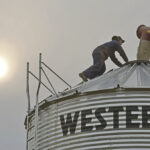
Tag Archives grain bins

Snuffing out grain storage problems before they begin
Grain is an excellent insulator that can hold warmth and moisture, so management is key

High-tech solutions bring bin management into focus
It's as simple as cooling the grain -- and as complex as managing Mother Nature

Grain bin safety starts with a plan
A few key points can improve safety when you have to enter a bin

Be safe and profitable when storing grain
Best practices for safety and preventing spoilage in bins frequently cross over, says safety expert

Large bins may be too large when it comes to drying canola
Bins hold a lot more these days -- and that makes it challenging to push air through small seeds, such as canola

Dust storm, hurricane-force winds tear across U.S. upper Midwest

Don’t be complacent around grain storage hazards
The list of dangers is very long, and it includes people who aren’t properly trained

Better grain bin sensors could put you in the combine a week earlier
The key to an earlier start is being able to successfully dry down higher-moisture grain

Unpacking the dangers around bin entrapment
Forays to the inside of a grain bin can quickly turn tragic

Grain bins have regulatory, safety requirements
Farm safety experts say farms, even small family-run operations, are workplaces and are regulated accordingly


